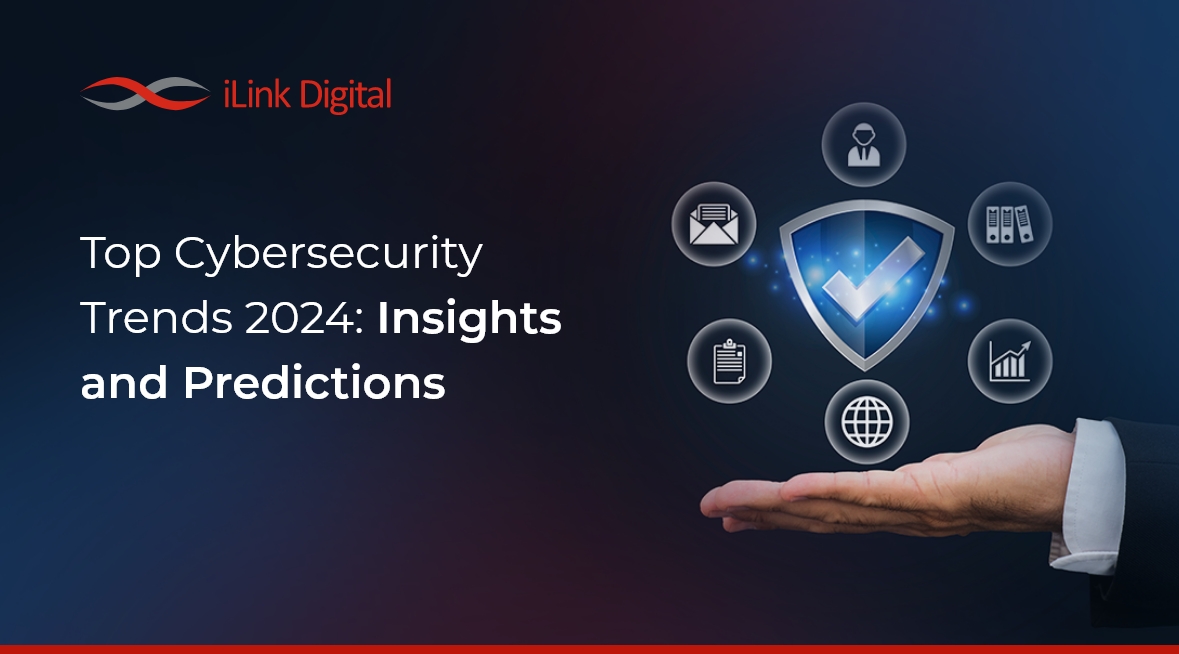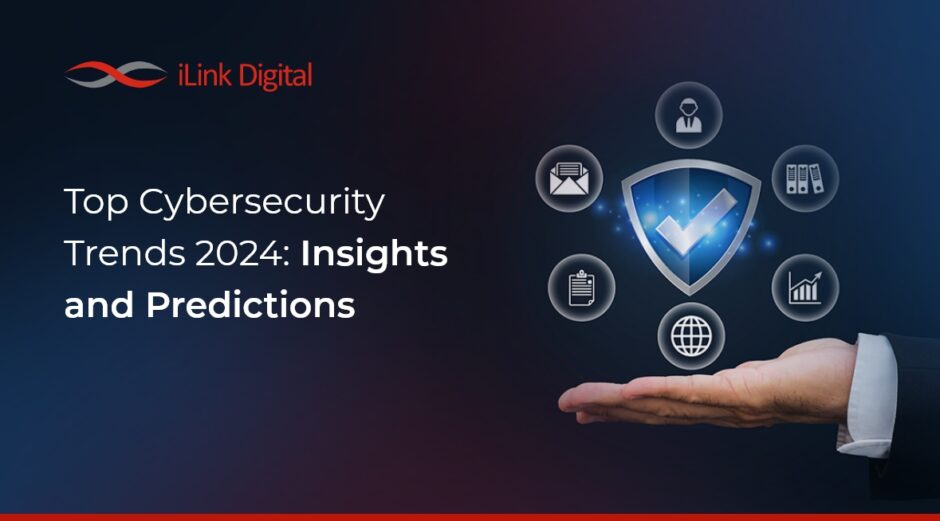Top Cybersecurity Trends 2024: Insights and Predictions
2024 has already brought formidable challenges in the realm of cybersecurity, requiring organizations to adopt a pragmatic approach to stay vigilant and maintain a robust security posture.
In 2024, organizations are still contending with an explosion of cyber incidents, including ransomware, phishing, and social engineering attacks. As attackers refine their tactics, the organization must embrace emerging trends and technologies to fortify their defenses.
In this comprehensive blog, we will explore top cybersecurity trends 2024, providing strategic insights into emerging cyber threats and actionable recommendations for effectively mitigating them.

Trend #1: Generative AI in Cybersecurity
According to Gartner, “The integration of GenAI into cybersecurity is projected to 30% reduction in false positive rates in threat detection and application security testing by 2027.”
Generative AI has become instrumental in empowering organizations to strengthen their cyber resilience by expediting threat detection, adversarial defense, and incident recovery processes. Unlike AI-native systems that learn based on predefined rules, Generative AI has instantiated the paradigm shift from reactive to proactive cybersecurity, assisting security teams to proactively identify potential vulnerabilities before they materialize, leading to making more informed decisions at their premises.
The leading use case of Generative AI in cybersecurity is crafting a hyper-realistic simulation of potential cyber-attacks in a controlled environment for training purposes, bolstering organizations’ readiness for real-world security incidents. GenAI can also assist in generating natural language threat assessments and incident summaries, speeding up the incident recovery process.
However, Generative AI acts as a double-edged sword in the threat landscape as it holds immense promise for both attackers and defenders. Hence, Gartner recommends that combining AI techniques with GenAI will create more robust systems, mitigating the weaknesses of both technologies and ensuring their responsible implementation.
As per Gartner’s recent survey, 34% of organizations are actively taking steps to mitigate the potential risks of Generative AI by implementing AI application security tools.
Check out our Generative AI Services!
Trend #2: Implementing Continuous Threat Exposure Management (CTEM)
Organizations often grapple with identifying overwhelming security vulnerabilities and prioritizing them accordingly despite having a well-curated and sorted list of security exposures. It is crucial to understand the attacker’s perspective to validate the true impact of vulnerability while evaluating the effectiveness of their existing defenses. It is essential to comprehend organizations cannot fix all vulnerabilities, nor can they be entirely certain which vulnerabilities require immediate remediation.
Gartner survey revealed that “By 2026, organizations will experience a staggering threefold decrease in the likelihood of a security breach by prioritizing their security investments based on CTEM”.
Continuous Threat Exposure Management (CTEM) is a pragmatic cybersecurity approach that consistently prioritizes potential vulnerabilities while balancing modern security realities. Unlike the reactive approach that can only address patchable exposures, CTEM accentuates real-time monitoring and analysis of unpatchable areas of exposure in the attack surface, enabling proactive risk mitigation and swift response to emerging cyber threats.
By conducting regular attack simulations on an organization’s assets, CTEM can effectively identify and address vulnerabilities before attackers exploit them. CTEM enforces continuous security posture remediation rather than point-in-time vulnerability assessment, enabling continual refinement of the organization’s security posture.
Trend #3: Extending the Role of Identity and Access Management (IAM)
Identity and Access Management (IAM) has transitioned from a gatekeeper to the cornerstone in the realm of cybersecurity, ensuring only authorized users have access to an organization’s critical resources. As organizations navigate the complexities of the ever-evolving attack surface, it is crucial to expand the role of IAM to encompass a wide range of responsibilities and capabilities. Hence, organizations started to embrace a paradigm shift towards an “identity-first” approach to security, significantly improving overall security posture.
Gartner recommends security officers prioritize strengthening and leveraging their identity fabric, providing a unified view of identities and access rights. Similarly, incorporating identity threat detection and response mechanisms is crucial to ensure IAM capabilities are better positioned to support overall security posture.
“By 2026, 40% of IAM leaders will be responsible for detecting and responding to IAM-related breaches”.
By integrating Privileged Access Management (PAM), Zero Trust, behavioral biometrics, and decentralized identities into IAM, organizations can achieve a holistic and resilient security posture while empowering users with secure access and fostering trust in the digital ecosystem.
Trend #4: Managing Third-Party Cybersecurity Risk Assessment
In today’s rapidly evolving landscape, managing third-party cybersecurity risk assessment has become critical imperative for organizations. Traditional point-in-time assessment often fail to capture the dynamic nature of cyberthreats. Considering the limitations of point-in-time assessments, organizations are embracing a more proactive and continuous monitoring and risk assessment approach, enabling them to mitigate potential cyber risks before they escalate into full-blown security incidents.
Gartner survey revealed that “Despite the higher investments in third-party cybersecurity risk management (TPCRM), 45% of organizations still suffered third-party business interruptions over the past two years”.
Gartner recommended that “Adopting a resilience-driven and resource-efficient approach into TPCRM helps organizations minimize the impact of third-party incidents.” Furthermore, establishing collaborative relationships with external partners is pivotal to developing mitigation strategies and contingency plans, ensuring critical assets are continuously safeguarded.
Trend #5: Reducing Human Risks with Security Behavior and Cultural Programs
Security professionals realized that the prevailing singular focus on enhancing employees’ security awareness is mainly ineffective in minimizing the security incidents caused by unsecured employee behavior. SBCPs have become one of the top cybersecurity trends that focus on risk reduction and understanding human behavior, fostering behavioral change to tackle the challenges of security fatigue, control friction, and organizational cultures with increased speed and agility.
Looking ahead, Gartner predicts that by 2027, 50% of large enterprises will have implemented human-centric security design practices. It helps to prioritize user experience while maintaining strong security controls, ultimately increasing the adoption of security controls while reducing security-induced friction.
This holistic approach encompasses both traditional practices and emerging capabilities to reduce the risk exposure of human factors while empowering employees, fostering a culture of security awareness, and leveraging data analytics, ensuring a digitally secure culture. However, effective implementation of SBCP requires the adoption of the Gartner PIPE (Practices, Influences, Platforms, Enablers) framework.
Bottom Line
The future of cybersecurity is evolving towards a proactive, intelligence-driven, and user-centric approach. By embracing top cybersecurity trends 2024 and implementing robust security strategies, organizations can gain a competitive advantage in the dynamic threat landscape.
Elevating your security measures is imperative. We are here to provide steadfast support every step of the way. At iLink Digital, we offer cutting-edge AI-driven cybersecurity solutions featuring 360-degree monitoring and round-the-clock support. With our tailored approach, businesses can effectively safeguard their critical assets, bolstering their resilience against emerging threats and enabling informed decision-making to enhance business agility.




